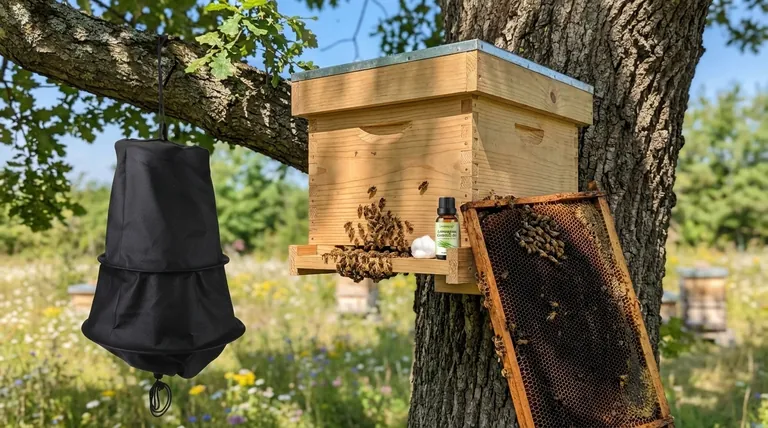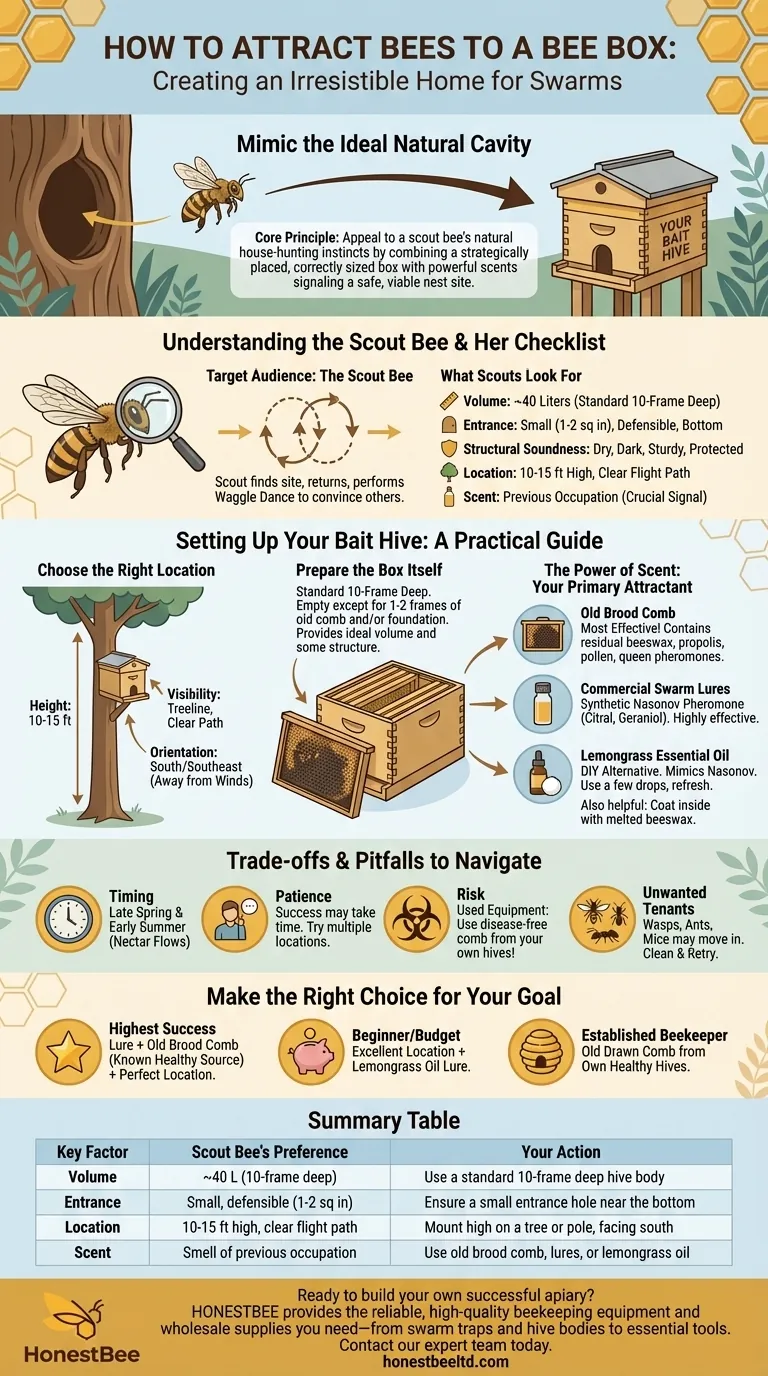To attract a honey bee swarm to a bee box, you must create an irresistible new home that appeals to their natural house-hunting instincts. This is achieved by combining a strategically placed box of the correct size with powerful scents that signal a safe, viable nest site. The most effective attractants are commercial swarm lures, old beeswax comb, and lemongrass essential oil.
The core principle is not to simply "bait" a box, but to mimic the ideal natural cavity that scout bees are genetically programmed to search for. Success hinges on understanding the swarm's perspective, where location and scent are far more important than the box itself.

Understanding Swarm Behavior: The Bee's Perspective
Attracting a swarm is less about magic and more about applied biology. A swarm is a honey bee colony's natural method of reproduction. When a colony becomes too large, the old queen leaves with roughly half the worker bees to find a new home.
The Role of the Scout Bee
You are not trying to attract the entire swarm. Your target audience is a small group of experienced scout bees. These scouts leave the clustered swarm to investigate potential nest sites. If a scout finds your box and deems it suitable, she will return to the swarm and perform a "waggle dance" to convince other scouts to inspect it.
What Scouts Look for in a New Home
Scout bees have a specific checklist for a five-star property. Research has shown they overwhelmingly prefer:
- A specific volume: Roughly 40 liters, the size of a standard 10-frame deep hive body.
- A small, defensible entrance: About 1 to 2 square inches, preferably near the bottom of the cavity.
- Structural soundness: A dry, dark, and sturdy interior protected from the elements.
- A strategic location: Typically 10 to 15 feet off the ground with a clear flight path.
- The scent of previous occupation: This is the most crucial signal that a location is a proven, safe home for bees.
Setting Up Your Bait Hive: A Practical Guide
A "bait hive" or "swarm trap" is simply a box prepared to meet the scouts' criteria.
Choose the Right Location
Location is your most critical variable. A perfectly prepared box in a poor location will likely fail.
- Height: Mount your bait hive securely 10 to 15 feet high on a tree or pole.
- Visibility: Place it along a treeline or on a solitary tree so it is visible to passing scouts.
- Orientation: Face the entrance south or southeast, away from prevailing winds.
Prepare the Box Itself
Use a standard 10-frame deep or an 8-frame deep hive body. This provides the ideal interior volume. Ensure it is empty except for one or two frames of old comb and/or frames with foundation. Providing some internal structure is better than a completely empty box.
The Power of Scent: Your Primary Attractant
This is how you signal "bees lived here before." You have several options, from most to least effective.
- Old Brood Comb: A frame of old, dark comb from a previous hive is the single best attractant. It contains the residual scents of beeswax, propolis, pollen, and queen pheromones.
- Commercial Swarm Lures: These are small vials containing synthetic Nasonov pheromone (specifically citral and geraniol). This scent is used by bees to orient themselves to a new home. It is highly effective and easy to use.
- Lemongrass Essential Oil: This is a popular and inexpensive DIY alternative. It mimics a key component of the Nasonov pheromone. Place a few drops on a cotton ball inside the hive. Refresh it every few weeks.
- Beeswax: As noted in your reference, coating the inside of the box and the frames with melted beeswax can help, as the scent is inherently attractive to bees.
Understanding the Trade-offs and Pitfalls
Capturing a swarm is a game of probability, and success is never guaranteed. Understanding the common challenges is key to managing your expectations.
Timing is Everything
Swarms primarily emerge in a 4-6 week window in late spring and early summer when nectar flows are strong. Putting a bait hive out in late summer or fall is highly unlikely to attract a swarm.
Patience and Persistence
Even with a perfect setup, you may not catch a swarm in your first year. Success often requires placing multiple bait hives in different locations to increase your odds. Check them every week or two from a distance.
The Risk of Used Equipment
While old comb is the best attractant, it can also harbor pathogens like American Foulbrood (AFB) spores, which can remain viable for decades. Only use comb from your own hives that you know are disease-free. Never use old equipment from an unknown source.
Unwanted Tenants
Your desirable bee real estate can also attract other creatures. It is common to find wasps, ants, or even mice have moved in first. You will need to clean out the box and try again.
Making the Right Choice for Your Goal
Your strategy should align with your resources and commitment level.
- If your primary focus is the highest chance of success: Use a commercial swarm lure combined with one frame of old, dark brood comb from a known healthy source in a properly located hive body.
- If you are a beginner on a budget: Focus intently on an excellent location and use a few drops of lemongrass essential oil as your scent lure inside a standard hive body.
- If you are an established beekeeper: Your best and most reliable tool is using frames of old, drawn comb from your own healthy, disease-free hives.
Ultimately, successfully attracting a swarm is about creating an irresistible real estate opportunity that a discerning scout bee cannot ignore.
Summary Table:
| Key Factor | Scout Bee's Preference | Your Action |
|---|---|---|
| Volume | ~40 liters (10-frame deep) | Use a standard 10-frame deep hive body |
| Entrance | Small, defensible (1-2 sq in) | Ensure a small entrance hole near the bottom |
| Location | 10-15 ft high, clear flight path | Mount high on a tree or pole, facing south |
| Scent | Smell of previous bee occupation | Use old brood comb, swarm lures, or lemongrass oil |
Ready to build your own successful apiary?
As a commercial beekeeper or equipment distributor, you need reliable, high-quality supplies to manage your operations effectively. HONESTBEE provides the durable beekeeping equipment and wholesale supplies you need—from swarm traps and hive bodies to essential tools—to support your success.
Contact our expert team today to discuss your wholesale needs and discover how HONESTBEE can be your trusted partner in beekeeping.
Visual Guide

Related Products
- HONESTBEE Collapsible Tiered Bee Swarm Catcher for Beekeeping
- HONESTBEE Professional Long Handled Hive Tool with Precision Cutting Blade
- Professional Insulated Plastic Bee Hives
- Portable Bee Mating Hive Boxes Mini Mating Nucs 8 Frames for Queen Rearing
- Twin Queen Styrofoam Honey Bee Nucs Mating and Breeding Box
People Also Ask
- Can a nuc box be used for swarm catching? An Effective and Manageable Solution for Beekeepers
- Do honey bees leave their hives? Understanding the Critical Role of Swarming
- What do beekeepers use to attract bees? Master Swarm Capture & Hive Management
- How to attract bees to a hive box? Proven Methods for Swarm Capture & Colony Expansion
- What are the three main ways to obtain honeybees? Choose the Best Path for Your Apiary



















